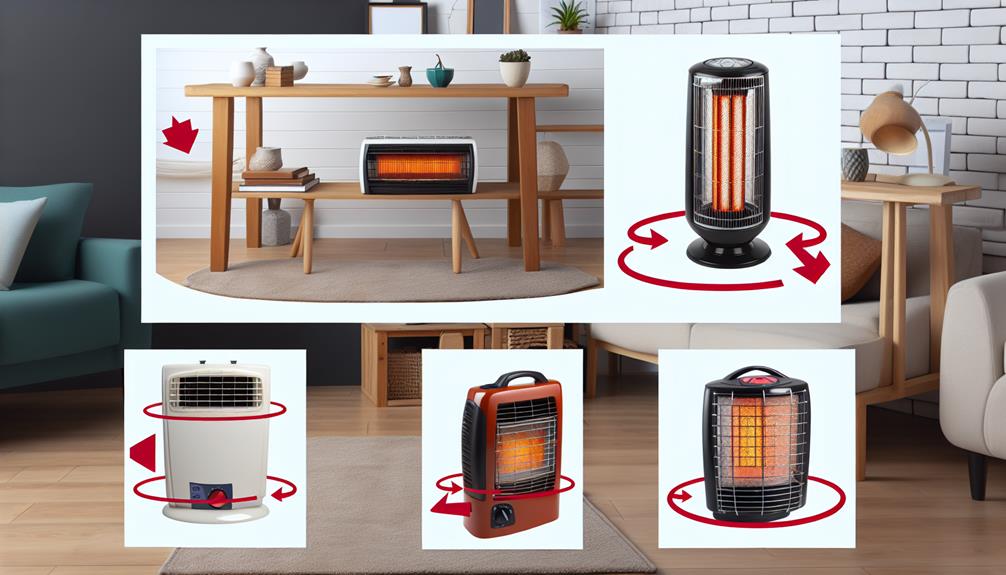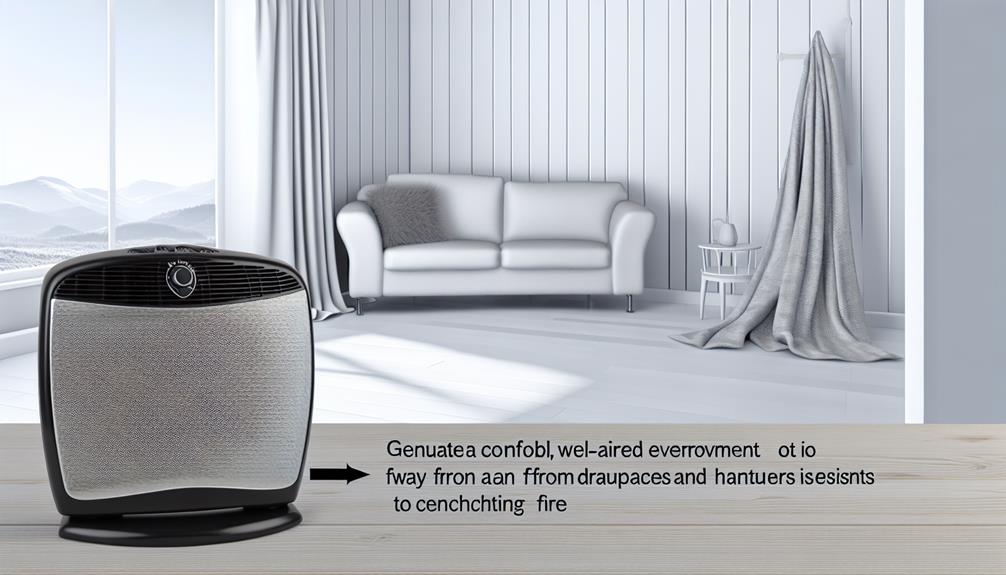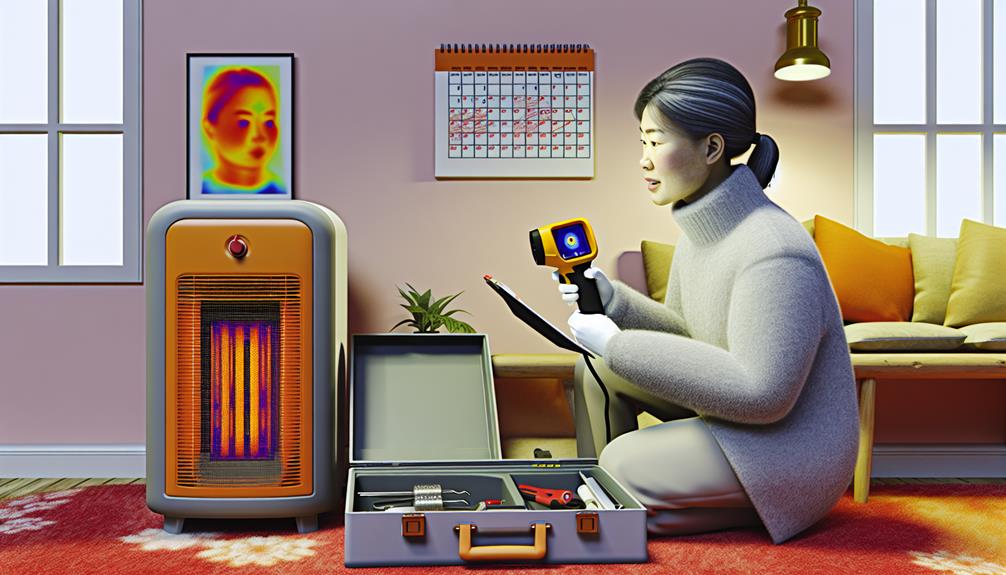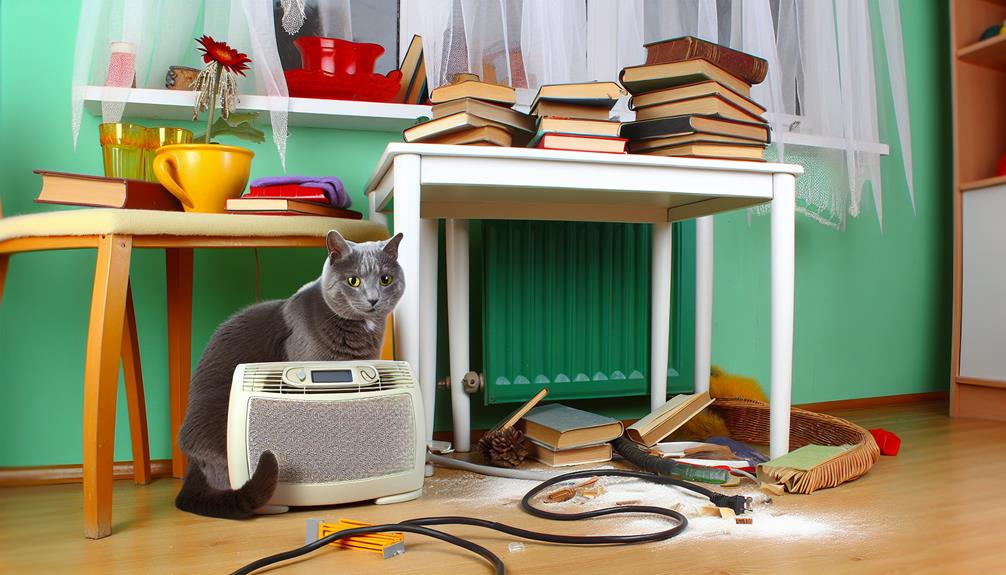As the winter chill nestles into the corners of your home, a portable heater becomes your personal sentinel against the cold, standing guard and offering warmth. But while you're relishing the cozy comfort, it's crucial to remember that this vigilant little appliance demands respect and understanding to serve you safely. You wouldn't entrust your safety to a stranger, so why do so with a device that, if mishandled, can become a hazard? To ensure your portable heater doesn't turn from friend to foe, there are some key measures you need to know—like selecting the right type for your space, understanding the nuances of its operation, and mastering the art of proper storage. As temperatures continue to drop, you'll want to stay informed about how to keep your haven warm without igniting unwelcome surprises. So, let's unpack the essentials of safeguarding your space with these trusty devices, because what you don't know could leave you out in the cold.
Key Takeaways
- Understanding the different types of portable heaters and choosing the right size
- Placing and operating heaters safely, considering clearance requirements and ventilation
- Regular maintenance and inspection routines for safe operation
- Implementing child and pet safety measures, including creating a safety zone and using physical barriers
Understanding Portable Heater Types

To choose the right portable heater for your needs, it's essential to understand the various types available, each with its unique mechanisms and applications. You'll find that portable heaters generally fall into categories like convection, radiant, and combination units, with specific models designed for different room sizes and situations.
Convection heaters are ideal for heating entire rooms evenly. They work by circulating warm air throughout the space, often using a fan. Look for models with thermostat features that allow precise temperature control, contributing to energy efficiency by preventing the unit from operating unnecessarily when your desired warmth is achieved.
Radiant heaters, on the other hand, provide direct heat to objects and people in their path. They're perfect for spot heating or in areas where you don't need to warm the entire room. Since they don't rely on fans, they operate quietly, but keep in mind they can be less energy-efficient if used as the primary heat source for a large area.
Combination heaters offer the best of both worlds, using a fan to help distribute the radiant heat they produce. These can be versatile and effective but may consume more energy due to their dual mechanism. It's wise to choose a model with energy-saving modes and programmable thermostat features to optimize usage and maintain comfort without wasting power.
Choosing the Right Heater Size
Once you've grasped the different types of portable heaters, it's crucial to select a unit whose size aligns with the area you intend to warm. Heater efficiency and energy consumption are two pivotal factors that determine the appropriateness of a heater for your space. It's not just about finding a heater; it's about finding the right heater.
To ensure optimal heater efficiency, you'll need to calculate the wattage required for your space. A general rule of thumb is that you need approximately 10 watts of heating power for every square foot of floor area. If you've got a room that's 150 square feet, a 1,500-watt heater should suffice. However, this estimation can vary depending on the room's insulation, ceiling height, and window area.
Now, consider energy consumption. A larger heater might heat up your space quickly, but it could consume more energy than necessary. This not only leads to higher electricity bills but also increases your carbon footprint. Conversely, a heater that's too small will struggle to maintain a comfortable temperature, causing it to run continuously and possibly wear out sooner. This inefficient cycle results in unnecessary energy waste and could leave you chilly despite your efforts.
To strike the right balance, look for a heater with adjustable settings that allow you to customize its output based on your immediate needs. Some models come with energy-saving modes and programmable timers, which can help manage energy consumption without compromising on warmth.
Placement and Space Requirements

Ensuring your portable heater's effectiveness involves more than just plugging it in; you'll need to consider the unit's placement and the space it requires for safe, efficient operation. The right location boosts heating efficiency, while the wrong one could lead to safety hazards and compromised performance.
Firstly, place your heater on a level, hard surface away from foot traffic to minimize the risk of it being knocked over. Soft surfaces like carpets can obstruct the heater's airflow, leading to overheating and reduced efficiency. Keep a minimum clearance of three feet around the unit—free from furniture, curtains, and other combustible materials—to ensure proper air circulation and prevent fire risks.
Ventilation concerns are also paramount when using a portable heater. While ensuring that the space is well-insulated to retain heat, it's critical to allow some airflow to prevent stale air and potential buildup of pollutants. If your heater uses fuel, like propane or kerosene, adequate ventilation is vital to avoid dangerous accumulation of fumes. Always follow the manufacturer's guidelines regarding ventilation requirements.
Furthermore, do not place the heater in damp areas like bathrooms unless it's specifically designed for such environments. Humidity can damage the internal components, leading to electrical hazards.
Lastly, never leave the heater running unattended, especially while sleeping. Before leaving the room or going to bed, turn it off to avoid any unforeseen incidents. By adhering to these placement and space requirements, you'll enjoy a warm, comfortable environment that doesn't compromise your safety or the heater's longevity.
Operating Heaters Safely
When operating portable heaters, you must adhere to specific safety guidelines to prevent fire hazards and ensure efficient functioning. Regular maintenance and inspection are crucial; check your heater's cords for damage and the unit for dust accumulation before each use. Proper placement is also vital—keep the heater away from flammable materials and ensure it's on a stable, level surface.
Heater Placement Tips
To maintain safety and efficiency, it's crucial to place your portable heater on a level, non-flammable surface, away from any combustible materials. Ensure there's ample furniture clearance, with at least three feet of space around the heater. This buffer zone reduces the risk of heat-related damage or fire. Ventilation considerations are also paramount; never position a heater where it can obstruct airflow or in an enclosed space where hazardous fumes could accumulate.
Be mindful of foot traffic areas to avoid tripping hazards or accidental contact with the heater's hot surface. Keep it out of reach of children and pets, and always directly supervise any heater in use. By following these guidelines, you'll optimize the safety and operation of your portable heater.
Maintenance and Inspection Routines
Regular maintenance and thorough inspections are a heater's best defense against wear and tear, ensuring it operates safely and efficiently throughout its lifespan. It's imperative you check and replace filters as recommended by the manufacturer to prevent dust and debris from hindering your heater's performance. Clogged filters not only reduce efficiency but can also pose a fire hazard.
Moreover, always be mindful of warranty considerations. Adhering to the prescribed maintenance routine may be a condition for keeping your warranty valid. That means keeping up with routine checks, promptly addressing any mechanical issues, and using only approved parts for repairs. An annual inspection by a qualified technician can catch potential problems early, reducing the risk of unexpected breakdowns and helping you stay cozy and safe all winter long.
Regular Maintenance Checks

Ensuring your portable heater operates safely and efficiently requires periodic maintenance checks, ideally before each heating season. You've got to make sure that you're not just plugging in your device and hoping for the best. Filter cleaning and wiring inspection are two critical components that you can't afford to overlook.
Let's start with filter cleaning. Your heater's filter is a frontline defense against dust and debris. When it's clogged, your heater has to work harder, which can lead to overheating and reduced efficiency. Make it a habit to check and clean the filter regularly. If your heater's manual specifies a cleaning interval, follow it to the letter.
Wiring inspection is just as important. Faulty wiring isn't something to mess around with—it can be a fire hazard. Check for any frayed cords or loose connections. If you spot any damage, it's time to cease using the heater and consult a professional. Don't try to fix electrical issues on your own unless you're qualified.
Here's a table to guide you through a basic maintenance check:
| Maintenance Task | Frequency | Notes |
|---|---|---|
| Filter Cleaning | Monthly | Check the manual for specifics. |
| Wiring Inspection | Bi-annual | Look for fraying or loose connections. |
| Surface Cleaning | Weekly | Wipe down to prevent dust accumulation. |
| Function Test | Each Use | Ensure all settings are working properly. |
| Storage Check | Annual | Before storage, ensure it's clean and dry. |
Child and Pet Safety Measures
As you integrate portable heaters into your home, it's crucial to prioritize the safety of your children and pets. You'll need to establish clear boundaries to prevent accidental burns or fires, ensuring these vulnerable family members remain at a safe distance. Moreover, securing your heater in a stable position and educating your household on proper use are essential steps to mitigate any risks associated with these heating devices.
Establish Safety Boundaries
When using portable heaters in a home with children and pets, it's crucial to establish clear safety boundaries to prevent accidents and injuries. Create safety zones around your heater, ideally a minimum of three feet from any flammable material or high-traffic area. This buffer serves as a fire barrier, reducing the risk of heat-related mishaps. It's essential to educate your children about these zones and the dangers of touching or playing near heaters. For added protection, consider installing physical barriers or gates to block young children and pets from accessing the heater. Always supervise their activity in rooms where heaters are in use, and reinforce the significance of these safety zones to maintain a secure and warm environment in your home.
Secure Heater Placement
To safeguard your children and pets, it's imperative to choose a stable, level surface for your portable heater, well away from play areas and traffic paths. Here's how you can ensure a secure placement:
- Identify an area that's out of reach for toddlers and pets, potentially elevated or behind a barrier.
- Utilize heater anchors if available to secure the heater to the wall, preventing any accidental tipping.
- Assess ventilation concerns; ensure the heater is at least three feet away from any fabric or flammable material.
- Regularly inspect the space around the heater to maintain clearances and confirm that no toys or pet beds have encroached upon the heater's safety zone.
These steps will help minimize risks and protect your most vulnerable family members.
Educate on Heater Use
Having established a secure placement for your portable heater, it's equally crucial to educate all household members, especially children, on the importance of safety measures around these devices. Teach them that heaters are not toys and must be treated with respect to prevent accidents. Explain that touching the heater can lead to burns, and placing objects too close can pose a fire hazard. Highlight the connection between heater efficiency and proper use; a correctly operated heater not only ensures safety but also reduces energy consumption. Make sure kids and pets maintain a safe distance, and never leave them unsupervised in a room with a working heater. By instilling these habits, you'll safeguard your loved ones and promote a warm, energy-efficient home.
Safe Storage Practices
Storing your portable heater properly is crucial to ensure its longevity and prevent potential hazards. When you've finished using your heater for the season, or if you're putting it away for a short period, there are specific steps you should take to store it safely. This not only involves the physical placement of the heater but also the handling of any fuel and ensuring proper ventilation during storage.
Here are four key steps to keep in mind:
- Cool Down Before Storage: Always allow your portable heater to cool completely before storing. This might seem obvious, but it's an essential step to prevent fires or damage to storage areas.
- Fuel Disposal and Storage: If your heater uses fuel, ensure you've emptied it according to the manufacturer's instructions. Store any remaining fuel in a cool, well-ventilated area, away from any heat sources. Improper fuel disposal or storage can lead to dangerous fumes or fire risks.
- Ventilation Considerations: When deciding on a storage spot, choose an area with good ventilation. This is particularly important for fuel-burning heaters to prevent any buildup of fumes that could be hazardous if they're accidentally ignited.
- Protect from Dust and Moisture: Store your heater in a dry place and cover it with a breathable material to prevent dust from accumulating on its components. Avoid plastic covers that can trap moisture, leading to rust or mold.
Recognizing Common Hazards

As you rely on portable heaters to keep warm, it's vital to be aware of the common hazards they present, including the risk of fire, carbon monoxide poisoning, and electrical accidents. Fire risks are arguably the most immediate concern. Portable heaters can easily ignite nearby flammable materials such as curtains, bedding, clothing, and furniture if placed too close. It's crucial to maintain a safety clearance of at least three feet from all combustible items.
Another serious threat is carbon monoxide (CO) poisoning, especially from fuel-burning heaters. CO is a colorless, odorless gas that can cause illness and even death if inhaled in large quantities. Ensuring proper ventilation is imperative to prevent CO buildup. Never use a fuel-burning heater in a completely sealed room, and consider installing CO detectors near sleeping areas for added safety.
Electrical accidents, including shocks and overheating, can also pose significant dangers. To reduce these risks, avoid plugging heaters into extension cords or power strips, which may not be able to handle the high current demands. Instead, plug them directly into a wall outlet. Regularly check the heater's cord for any damage, such as fraying or cracking, and never operate a heater with a compromised power cord.
Emergency Preparedness Tips
To ensure your safety when using portable heaters, it's crucial to have a well-thought-out emergency plan in place. Disasters can strike without warning, and being prepared can make all the difference. Here are some steps to consider when creating your emergency preparedness plan:
- Assemble Disaster Kits: Your disaster kit should include basic necessities such as water, non-perishable food, a flashlight, batteries, a first aid kit, and medications. Remember to tailor your kit to the needs of everyone in your household, including pets. Store it in a location that's easily accessible in case of an evacuation.
- Create and Practice Communication plans: Establish a family communication plan that includes emergency contact information, meeting points outside of your home, and an out-of-town contact to check in with if local lines are busy. Regularly practice this plan to ensure everyone knows what to do and where to go.
- Maintain Your Portable Heaters: Regularly inspect your heaters for any signs of wear or damage. Keep them clean and store them properly when not in use. Always have a backup heating method in case your primary heater fails during a severe weather event.
- Educate Yourself and Family: Learn how to shut off utilities like gas, electricity, and water in your home. Familiarize yourself with local emergency services and shelters. Teach all family members how to safely operate portable heaters and what to do in case of carbon monoxide alarms or fire.
Frequently Asked Questions
How Does the Use of a Portable Heater Affect My Home Insurance Policy?
Like a spark in dry grass, the use of a portable heater can ignite changes in your home insurance policy. It's crucial to check with your insurer as coverage changes may apply. They'll reassess the risk to your cozy nest, potentially adjusting your premiums or terms. It's all about minimizing fire hazards and ensuring you're adequately covered, so always inform them to keep your policy as warm and secure as your heated space.
Can I Use a Portable Heater With an Extension Cord or Power Strip?
You shouldn't use a portable heater with an extension cord or power strip due to the risk of overheating and potential fire hazards. Always check for adequate cord durability and necessary safety certifications when selecting heating equipment. Directly plug your heater into a wall outlet to ensure it operates within safe parameters. It's crucial for your safety to follow these guidelines meticulously.
Are There Eco-Friendly Portable Heaters That Consume Less Energy but Are Still Effective?
Yes, you can find eco-friendly portable heaters that balance energy efficiency with effectiveness. Contrasting traditional models, these green alternatives use advanced technologies to reduce electricity consumption while still delivering cozy warmth. They're designed to provide targeted heating without wasting energy, so you'll stay comfortable and save on bills. Look for heaters with programmable thermostats and eco-modes to maximize their efficiency and minimize your carbon footprint.
How Can I Safely Dispose of an Old or Broken Portable Heater?
To safely dispose of an old or broken portable heater, consider heater recycling programs that handle electronic waste responsibly. Some local waste management services provide special drop-off locations or pick-up services. Additionally, if it's still functional, explore donation options with local charities or thrift stores. They might accept it, giving your heater a second life while helping someone in need. Always ensure you're following your area's guidelines for disposal or donation.
What Should I Do if My Portable Heater's Plug or Cord Gets Unusually Warm or Hot to the Touch During Use?
If your heater's plug or cord feels hot, it's like a red flag waving at a bullfight—an electrical hazard in the making. Don't ignore it. Unplug the device immediately and avoid using it until a professional can assess the risk. This heat signals potential wiring issues. Follow maintenance tips: routinely check your heater's cables, and if they're damaged, repair or replace the unit to prevent any dangerous mishaps.
